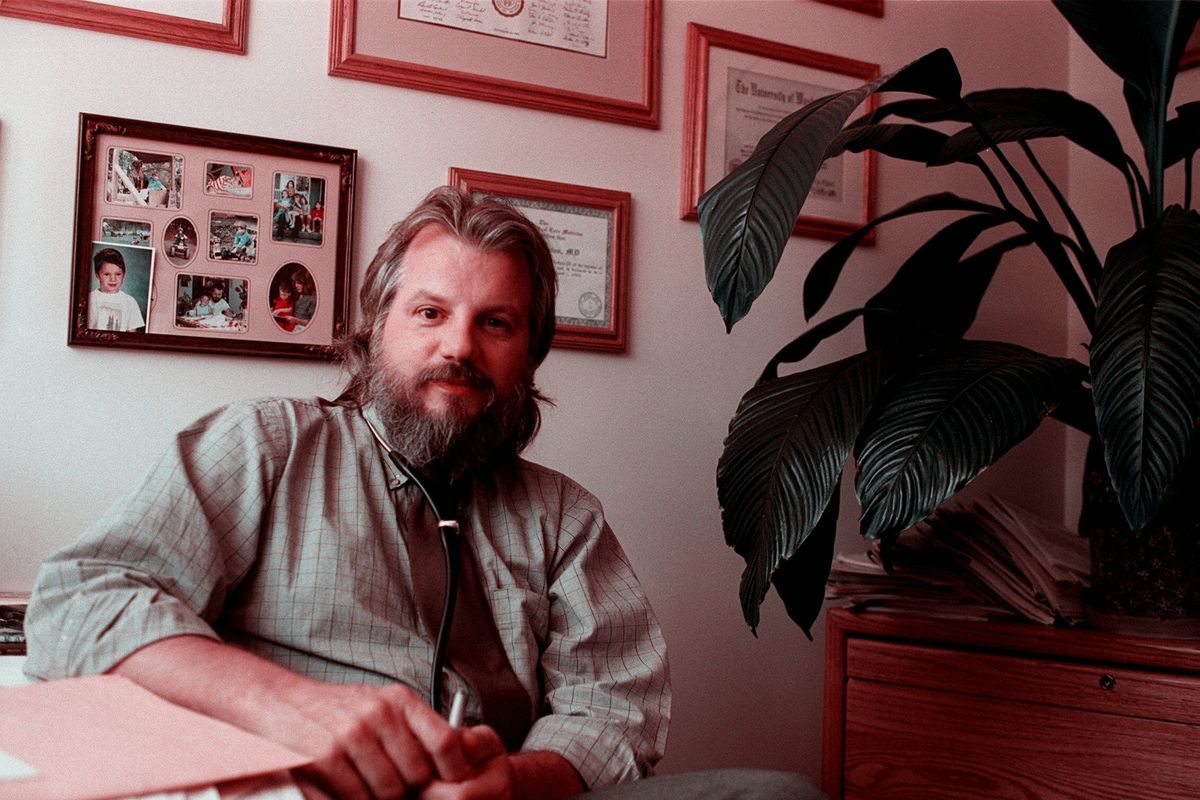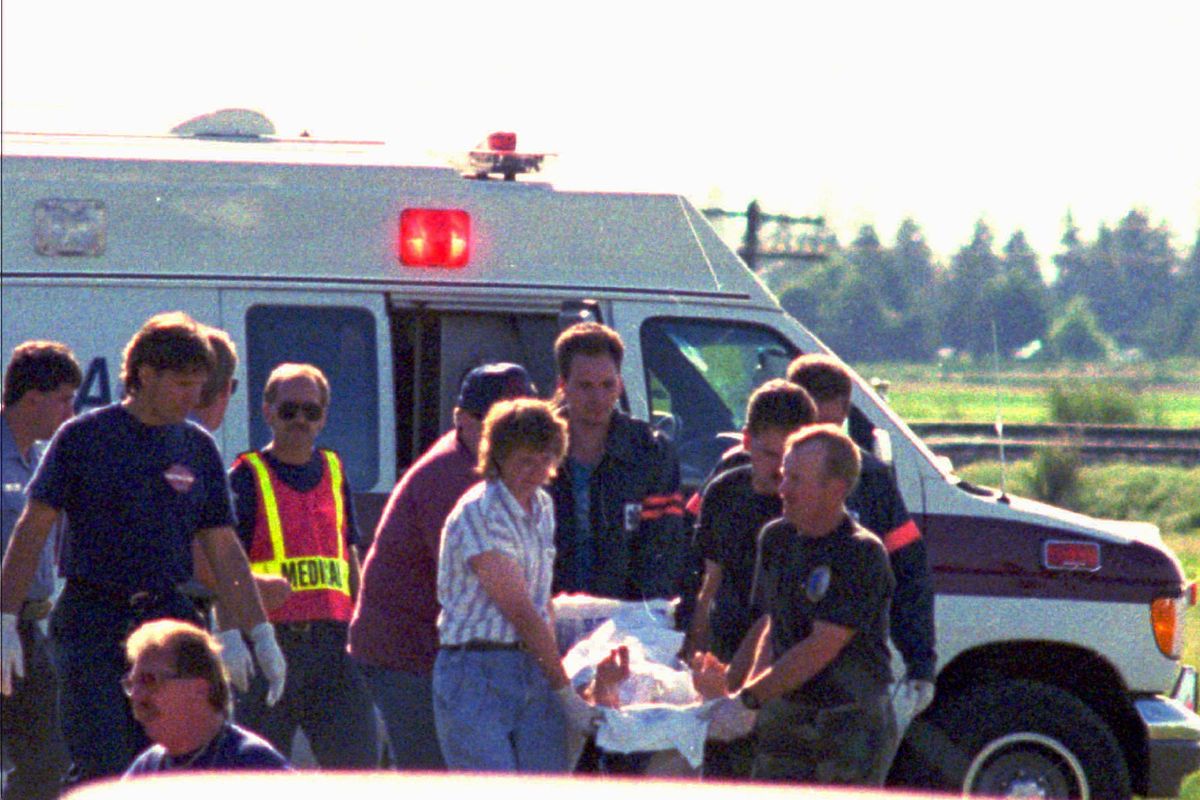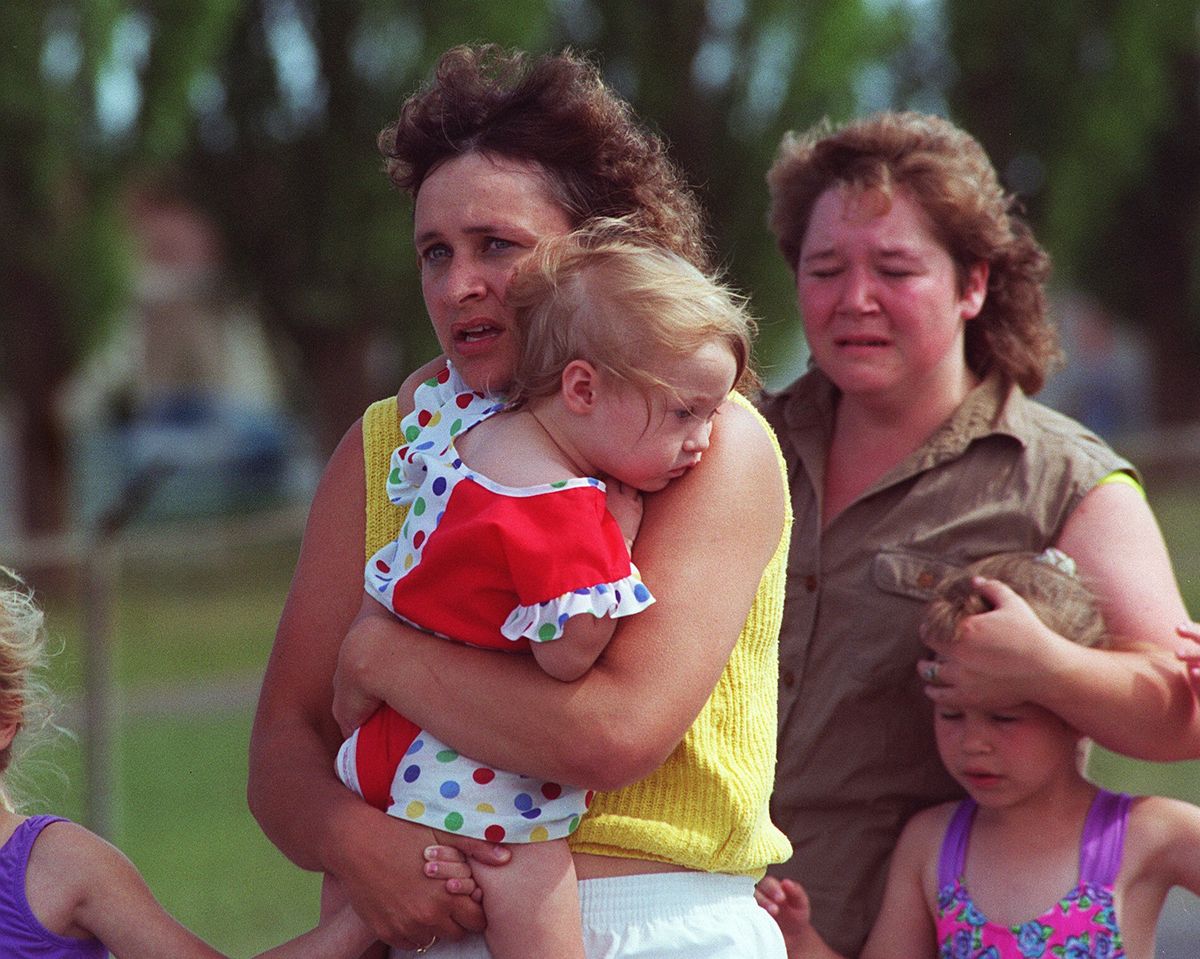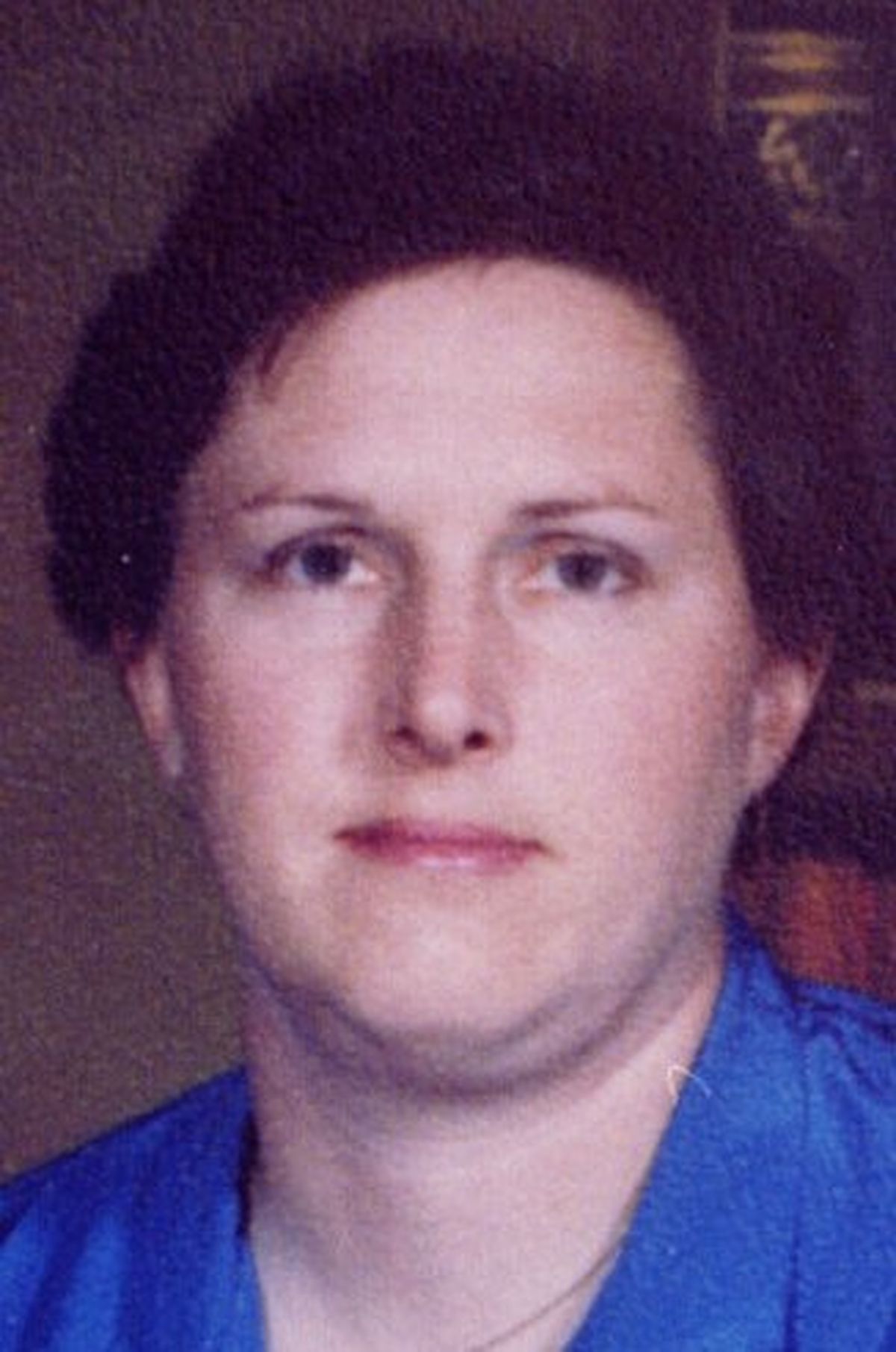Andy Brown: Helping the other survivors of the Mellberg rampage
Medical crews move a shooting victim from an ambulance to a helicopter Monday, June 20, 1994, after a gunman opened fire at Fairchild Air Force Base outside of Spokane. Dean Mellberg killed four people before being fatally shot. Twenty three others were wounded by the gunman, who was an airman at the base. (FILE / Associated Press)
Spin Control note: Today's newspaper column has items recast from last week. For regular Web readers, however, here's a profile that's a hopeful update for the 16th anniversary of one Spokane's biggest tragedies.
A psychotic gunman made Andy Brown into a hero 16 years agocq june 20.
He became a legend, the guy who made “the shot” that stopped Dean Mellberg's murderous rampage through the Fairchild Air Force Base hospital complex on June 20, 1994. Brown He got a medal and a move to Hawaii.
But the mantle of hero never sat comfortably on Brown, who was a 24-year-old Air Force security policeman on bike patrol that day. It gnawed at him that Mellberg was able to kill and maim people on his watch. Months later, Brown found himself struggling with so much anxiety that his hands would shake when making a routine traffic stop.
He knew he needed help, but discovered a Catch-22 that military police officers face: He could have counseling for post-traumatic stress symptoms only if he turned in his badge and gun.
“I stopped seeking counseling. I pretty much stuffed down any feelings I was starting to have.”
They didn't stay stuffed down and eventually Brown, who'd hoped to have a career in military law enforcement, left the Air Force with a medical disability. Now he's trying to help other law enforcement officers avoid the same fate, keep connected with some of the other survivors and understand what caused Mellberg to snap.
He's started a website and is working on a book...
For the rest of the story, go inside the blog
A call to the hospital
June 20, 1994 started as a routine day for Sr. Amn. Andy Brown, a
five-year veteran of the Air Force. He'd been at Fairchild for about
six months as a security policeman, and just recently assigned to bike
patrol. It was a sunny, cloudless Monday, he recalled: people were out
washing their cars as he pedaled through base housing. Radio traffic
was light.
He was talking with a friend at a security gate when they heard a radio
call about shooting at the hospital nearby. He got on his bike and
pedaled hard toward the medical complex; as he approached people and
cars were streaming the other way. Where is he, where is he? Brown
asked.
And then he saw a man holding a rifle in the street in front of the
hospital entrance. Brown parked his bike about 80 yards away and walked
forward about 10 yards, drawing his Beretta M9 and dropping to his
right knee. He steadied his handgun and told the gunman to drop his
weapon. The man turned and pointed the rifle at him.
“Witnesses said he fired in my direction. I don’t remember that but some part of me believes he was shooting in my direction.”
Brown took careful aim and fired four shots in controlled succession.
On the fourth, the man kicked his legs, spun around and fell on his
back. Brown stood up and went toward a pickup truck for cover. The
radio traffic had reported a second gunman, a sniper on the hospital
annex roof. He waited for backup, watching the still figure on the
ground.
But the reports proved wrong. Mellberg, a mentally unstable 20-year-old
who'd been forced out of the Air Force two months earlier, was acteding
alone. His shooting spree was his attempt at revenge on the
psychologist and psychiatrist he blamed for ending his Air Force
career. He killed Drs. Tom Brigham and Alan London first, then three
more people, while seriously injuring injured another 22 before being
stopped by Brown.
The shot
A Beretta M9 is the Air Force's standard issue for security police, and
all officers must prove their proficiency with their sidearm. Andy
Brown practiced regularly and usually shot well enough to be rated
expert, but no one practices shooting that handgun at targets 70 yards
away.
“He seemed closer,” Brown said recently. “I didn't think it was out of range.”
When Mellberg didn't fall after the first two rounds, Brown wondered if
the gun was misfiring. The round that killed Mellberg – Brown's fourth;
the third hit him in the shoulder and went through – became known as
“the shot.”
Brown became a hero, a label that made him uncomfortable because he
felt so many people performed heroically that day, getting hospital
patients to safety or saving the lives of injured victims. The news
media was calling for interviews, which he was reluctant to do while
victims were recovering in hospitals or being buried by their loved
ones.
“I didn't want to keep the incident alive in the media. It was naïve at the time, because it wasn't going to go away.”
He also thought too much attention and praise was being lavished on
him, while some of the medical staff who braved Mellberg’s gunfire to
help the wounded got the short shrift
Brown was given a chance for counseling with the Spokane Police
Department psychologist Deanette Palmer. But after a few sessions, when
he returned to duty, he was told he’d have to stop counseling or turn
in his weapon. He quit counseling.
Hoping to get the tragedy behind them, Fairchild officials held a
memorial for the victims and an award ceremony for some security and
hospital staff. Brown received the Air Force Medal, and told to pick
any base where he’d like to serve. He thought about asking for McChord
in Tacoma, to be nearer his family in Port Orchard; friends at
Fairchild, however, suggested Hawaii, a better spot for a young, single
airman. He asked for and got a transfer to Hickam Air Force Base, where
he “bought a Harley and drove in circles around the island.”
But his police work was starting to bring increased anxiety,
irritability and depression. Sometimes on traffic stops, adrenaline
would make his hands shake. He asked about counseling, the Air Force
gave him tests with questions like: Do you hear voices? Do you see
ghosts? And if he went, he’d have to turn in his gun and come off duty.
He opted to stay on the job, and away from counseling.
Brown’s PTSD was predictable, and exactly why civilian law enforcement
agencies don’t pull officers off the street just because they’re in
counseling unless they’re a danger to themselves or others, said
Palmer, the Spokane Police PD psychologist who counseled Brown after
the shootings.
“There’s certainly not the stigma (to counseling) like there used to
be,” said Palmer, who has been the department’s psychologist for 20
years. “They would have protected him.”
Air Force officials say that is no longer the
policy, and that no one in the service would be relieved of their
weapon unless a mental health professional recommended it. But they
couldn’t say when the policy would have changed.
A new identity
When Andy Brown arrived at his new assignment in Hawaii, base, he
discovered his reputation preceded him as “that dude from Fairchild
that shot that guy.” It happened again when he was assigned to Kirtland
Air Force Base in New Mexico.
“I felt I had to live up to that,” he said. “It seems like it was going to happen anywhere I went.”
But Brown was wrestling with his feelings about the shooting, and it
had nothing to do with being a hero. Before the shooting, he’d thought
about having to shoot and possibly kill a dangerous person while on
duty. The scenario he’d pictured was of a bad guy going down.
“I never really prepared myself for other people getting hurt or
killed,” he said. Although he realizes now there was nothing he could
have done, he was haunted by the number of people wounded or killed
before he arrived.
Still unable to work and get counseling, Brown realized at Kirtland he
was “burning out.” He requested and received a medical discharge: “I
don’t want to sound like a whiner. I just wish things would have been
handled differently.”
He returned to Western Washington where his family lived, but in 1999
came to Spokane to visit an Air Force buddy who lived in Mead. The
buddy introduced Brown to his niece, Rhonda Strong, and Brown never
left Spokane; Andy and Rhonda married in 2002 and have two children.
He worked at factories, went to school for electrical maintenance, but
always felt drawn back to law enforcement, even though he knew he
didn’t want to be a cop on a beat. In 2006, he was hired by the Border
Patrol, where he works today as a dispatcher.
Sometimes a new acquaintance or co-worker will hear that Brown was at
Fairchild in the ’90s, and ask if he was there when the shootings
occurred or mention the amazing shot that stopped Mellberg.
“Sometimes I’ll say, ‘Yeah, I was there,’ and not go into detail,” he
said. “Other times I’ll say ‘That was me.’ I don’t mind if people know
about it anymore.”
As a veteran, Brown was able to get the counseling he couldn’t get in
the Air Force. He’s tried about every kind of therapy available, and
believes he’s reached the limit of what psychologists can do for him;
he has to work out the rest for himself.
“The whole thing is just tragically sad. I know it had to be done. I just wish it was only (Mellberg) who died.”
As part of coming to terms with that day in 1994, Brown is writing a
book about the incident, including Mellberg’s troubled history. The
young airman was recommended for discharge for psychiatric problems
almost from the time he enlisted, but medical recommendations were
overridden by administrators. When he finally was forced out, Mellberg
was escorted to the gate at his last assignment at Cannon Air Force
Base in New Mexico and told to leave without a treatment plan or even a
ticket to his parents’ home in Michgan. He traveled came to Spokane,
bought a semi-automatic rifle and came to Fairchild, where he started
his killing spree with the psychiatrist and psychologist he blamed for
ending his military career.
Brown is also writing about what happened to him and some survivors
afterward. He’s contacting some of Mellberg’s victims, who he never had
a chance to meet 16 years ago.
Last year he saw a marriage license in the newspaper for Melissa Moe,
who was 15 when she was shot by Mellberg. He sent her an e-mail. Moe
was thrilled and invited him and his family to her wedding; they’d
never met but she always thought of him as one of her heroes.
“I saw him on TV, getting his award, when I was coming out of intensive care,” she said.
The day of the wedding, Moe’s father was too ill to attend. Although
she hadn’t yet met Brown face-to-face, she didn’t hesitate to ask him
to walk her down the aisle. It was his turn to be thrilled.
Brown and his family are now like part of hers, she said, and he
“always has the right thing to say.” She understands the burden he
carries, because after the shooting people expected so much from her
and the other victims, too.
To help connect other victims of the Mellberg shootings, and to give
them a forum, Brown has started a website,
fairchildhospitalshooting.com. On it he wrote they can learn from each
other what works and what doesn’t. “We will see that we are not alone.”
He doesn’t know how long a book will take, but thinks there are plenty
of lessons to be learned from the shooting and its aftermath: “I
probably don’t realize them all myself yet.”




























